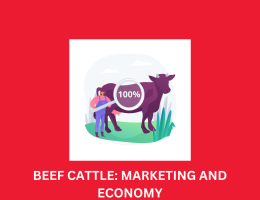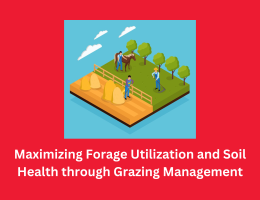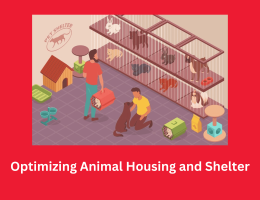
Maximizing Forage Utilization and Soil Health through Grazing Management: Strategies for Pastureland and Rotational Grazing
- By admin --
- Tuesday, 12 Mar, 2024
Introduction:
Grazing management is a crucial aspect of sustainable livestock production, as it directly influences forage utilization, soil health, and pasture productivity. Effective management strategies aim to optimize grazing patterns, rotation schedules, and stocking rates to maximize forage intake by livestock while preserving soil structure, fertility, and biodiversity. This essay explores strategies for managing pastureland and implementing rotational grazing systems to enhance forage utilization and maintain soil health.
Maximizing Forage Utilization:
Forage utilization refers to the efficiency with which livestock consume available pasture biomass, converting it into energy and nutrients for growth, reproduction, and production. Maximizing forage utilization involves several key strategies:
Monitoring pasture growth:
Regular monitoring of pasture growth and forage availability allows producers to make informed decisions regarding grazing timing, intensity, and duration. Tools such as pasture height measurements, biomass estimations, and grazing charts help ensure that livestock are grazing at the appropriate stocking rates to prevent under- or overgrazing.
Rotational grazing:
Rotational grazing involves dividing pastureland into smaller paddocks or grazing units and rotating livestock between them at regular intervals. This strategy allows forage to recover between grazing events, promoting regrowth and preventing overgrazing. Rotational grazing also encourages more uniform forage utilization, reduces selective grazing pressure, and improves pasture productivity over time.
Stocking density and duration:
Adjusting stocking densities and grazing durations according to forage availability, growth rates, and seasonal variations helps optimize forage utilization while preventing excessive trampling and soil compaction. High stocking densities and short grazing periods promote intensive foraging behavior, while lower densities and longer rest periods allow for greater forage recovery and regrowth.
Supplemental feeding and supplementation:
Providing supplemental feed or forage during periods of low pasture productivity, such as winter or drought, helps maintain livestock nutrition and performance while minimizing overgrazing and soil degradation. Supplemental feeding should be strategically managed to complement pasture-based diets and prevent nutrient imbalances or overreliance on external inputs.
Maintaining Soil Health:
Soil health is a critical component of sustainable pasture management, as it directly influences forage production, nutrient cycling, water infiltration, and ecosystem resilience. Key strategies for maintaining soil health in grazing systems include:
Soil conservation practices:
Implementing soil conservation practices such as contour plowing, terracing, and grassed waterways helps prevent soil erosion, runoff, and sedimentation in grazing areas. These practices protect soil structure, minimize nutrient loss, and preserve soil fertility for sustained pasture productivity.
Soil fertility management:
Maintaining optimal soil fertility levels through soil testing, nutrient management planning, and organic amendments supports healthy forage growth and livestock nutrition. Balancing soil pH, applying appropriate fertilizers, and incorporating organic matter enhance nutrient availability and uptake by pasture plants, promoting vigorous growth and resilience to grazing pressure.
Rotational grazing and rest periods:
Rotational grazing systems promote soil health by allowing forage to rest and recover between grazing cycles, reducing soil compaction, and enhancing root development. Rest periods enable soil microbial activity, nutrient recycling, and organic matter decomposition, contributing to soil structure, fertility, and biological diversity.
Diversification and multi-species grazing:
Introducing diverse plant species and integrating livestock species such as cattle, sheep, and poultry into grazing systems enhances soil health through increased plant diversity, nutrient cycling, and soil structure improvement. Multi-species grazing systems utilize complementary grazing behaviors and dietary preferences to optimize forage utilization and minimize selective grazing pressure on pasture vegetation.
Riparian and buffer management:
Protecting riparian areas and establishing vegetative buffers along waterways helps prevent soil erosion, sedimentation, and nutrient runoff from grazing activities. Riparian vegetation stabilizes stream banks, filters pollutants, and provides habitat for wildlife, contributing to overall ecosystem health and water quality improvement.
Conclusion:
In final analysis, the best way cows can graze better and keep pasture soils healthy is by using specific techniques at all times. Producers who want to make maximum use of pastures and at same time prevent overstocking will make it happen when they think about using rotational grazing together with monitoring pasture growth rates as well as using soil conservation techniques.





